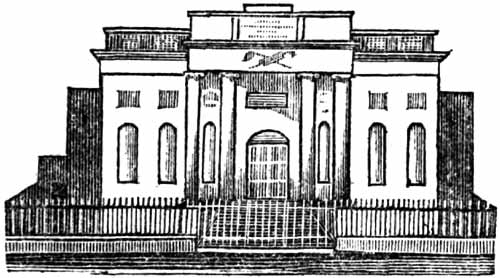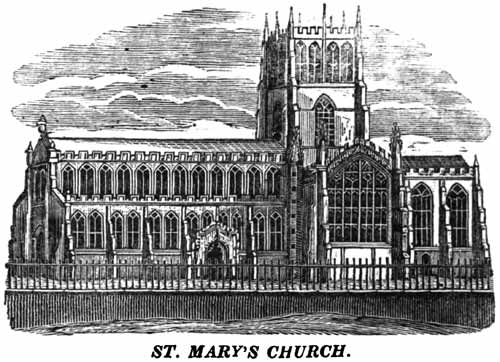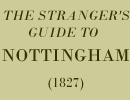< Previous | Contents | Next >
On the opposite side of the street, is a wide archway, the entrance to the
UNITARIAN CHAPEL,
which was probably the first dissenting place of worship in the town. It underwent a complete repair in 1805, being stuccoed, fined, and greatly improved. The ministers are the Rev. J. Tayler, and the Rev. B. Carpenter, and service is performed every Sabbath, at halfpast ten and three. The chapel is fifty-nine feet by fifty. Immediately adjoining are the
UNITARIAN CHARITY SCHOOLS,
where thirty boys and twenty-four girls are gratuitously educated, and partly clothed. The master is Mr. John Taylor.—Proceeding up the High-pavement, on the north side, is a beautiful mansion, the residence of Mrs. Fellows, and is distinguished from the others, by a beautiful vista on the opposite side of the street, which gives to the mansion the advantage of a charming prospect over an extensive tract of country. Immediately adjoining the vista, is the

COUNTY HALL AND JAIL,
a heavy-looking stone building, with an inscription on the pediment, which informs you it was erected in 1770. It is divided from the street by an iron railing. On ascending the steps, you enter the outer hall, which is lighted by a circular window or lantern at the top; on the right hand side is the nisi prius court, and on the left is the crown court, where the assizes and sessions are held. Immediately opposite the front entrance is a spacious room, where the petty sessions are held every Wednesday and Saturday, and this room is also used by the grand juries when they are sitting. At the west end of the room, hang the full length portraits of his late Majesty George III. and Queen Charlotte. These pictures were the gift of the Hon. C. H. Pierrepont, in 1805.—Behind the hall, and between it and Red-lion-street, is the spacious prison for the county, the entrance to which is by a gate at the west end of the palisades in the front of the building. The present jailer is Mr. Joseph Cross.—On the other side of the street is
ST. MARY'S CHURCH,
of which we give a spirited view as seen from the High-pavement, on the opposite page. This is called the mother church of the town, being

the most ancient. Indeed the date of its erection is not known, but it is supposed to have been built in the 15th century. The ground on which it stands is twenty-three yards above the level of the meadows. It is in the form of a cross, and has a handsome square tower, in which is a musical peal of ten bells.—This church was originally all in the Gothic style, but in 1726, the west end was rebuilt, when the uniformity of the place was destroyed, the Doric order being substituted, and instead of the lofty pinnacles which used to adorn that end, a Grecian urn was substituted. The dimensions of this church are, in the inside, from east to west, two hundred and sixteen feet, from south to north in the centre, ninety-seven feet, in the chancel twenty-nine feet, and at the west end, or principal entrance, sixty-seven feet. The height of the steeple is one hundred and twenty-six feet, and of the aisles sixty feet. The porch on the south side, as seen in the annexed view, is a very ancient piece of workmanship, on the fluting of the pediment of which was sculptured red and white roses, some traces of which may even yet be discerned.—In the west gallery is an excellent organ, of great power, built by the celebrated Statelet; the instrument is supported by two Tuscan columns, which may be seen to advantage in the ante-church, and over the columns is a picture of David playing on his harp. There are many monumental inscriptions, for here are the tombs of the first and second Earls of Clare, dated 1637 and 1665, also the Earl Meath, who died in 1715. Many of the ancient family of the Plumptres are also interred here, and the mausoleum of the family of the Wrights is distinguished by many tablets. In the north window of the chancel, is the figure of St. Andrew, in stained glass, defended by a wire protector. There is service at halfpast ten and halfpast six every Sabbath, and the Vicar is the Rev. George Wilkins, D.D.Leaving this holy and consecrated ground, the stranger will do well to cross to the opposite side of the High-pavement, where is a narrow passage, called Malin-hill, which takes us to what is called the Long-stairs, that lead into Red-lion-street, formerly called Narrow-marsh. Instead of descending these stairs, we go a little way down the hill, where a most interesting scene is presented to the view. Immediately below, on a level with your feet, are the chimneys of a thousand houses; beyond these is a view of the meadows, the London road, &c, and to the east on the top of the hill, is to be seen the neat little church of Snenton, forming altogether a prospect highly gratifying to the stranger. We must now turn back into the High-pavement, where, nearly opposite the County-hall, is a street called Mary-gate, at the corner of which is the Old Angel public house, formerly known as Bugge-hall, the mansion of a family of that name, from whom are descended the Willoughby's, and several other distinguished families. Here, if the traveller pleases, he may stop, and partake of a fair sample of the potent liquor, so well known by the name of Nottingham ale.
"Nottingham ale, boys, Nottingham ale,
"No liquor on earth like Nottingham ale."
The cause of the superiority of this beverage, is ascribed to a variety of causes; by some to the very fine barley grown in this and the adjoining counties, by some to the water, by others to the fuel, and lastly, to the excel. lent rock cellars in which the drink is stored, almost every house, of any extent in the town, having a cellar hewn out of the rock belonging to it. Without stopping to settle the question, which would take us rather too long, we will go up Mary-gate, where, on the left-hand side, is the
THEATRE,
a plain building, without windows, and occupied about three months in the year. The greater part of the middle classes in the town, being dissenters, will not encourage theatrical performances; and while we have many meetinghouses, the only theatre in the town, and that a small one, is not filled above two or three times in a season. A little further in the street, at the top of Pilcher-gate, is a noble mansion, the seat of Wm. Trentham, Esq. It was the ancient family mansion of the Sher-wins, and the ground on which it is built, is on a level with the Castle-yard. On the left hand side of Pilcher-gate, in Halifax-place, is
HALIFAX CHAPEL,
built by the Wesleyan Methodists, in 1798. It is the largest dissenting place of worship in the town, measuring eighty-four feet four inches by fifty-two feet ten inches. Divine service is performed here, on the Sabbath, at halfpast ten and six; and on Monday evenings at seven.—At the bottom of Pilcher-gate, on the north side, is
WARTNABY'S HOSPITAL.
Six rooms, given by Barnaby Wartnaby, in the year 1665, for the residence of three old men and three old women, who receive one shilling a week each, and have clothes and coal given every year. On that part of the building which fronts Fletcher-gate, is the following inscription:—
As God above out of his love,
has gave to me great store: out of my charity I gave,
these six houses to the poor'. So let us pray for one another,
as long as we do live: that we may go to him above,
who these to me did give. BARNABY WARTNABY. 1665.
We shall now pursue our course along Fletcher-gate, at the end of which, next Bottle-lane, is
SION CHAPEL,
built in the year 1819, for a sect of Independents attached to the high Calvinistic sentiments. This is a small but neat chapel, with school rooms attached. The minister is the Rev. James Jacks, and the services are at halfpast ten, three, and half past six on the Sabbath; and at seven on Tuesday evening.
